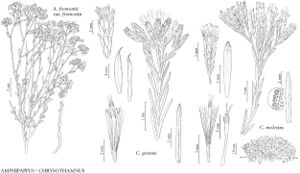Chrysothamnus
Trans. Amer. Philos. Soc., n. s. 7: 323. 1840.
| Taxon | Illustrator ⠉ | |
|---|---|---|
 | Amphipappus fremontii Chrysothamnus greenei Chrysothamnus molestus | Barbara Alongi John Myers John Myers |
Shrubs or subshrubs, 8–120 cm (often rounded, compact; usually with woody, often highly branched caudices). Stems ascending to erect or spreading (greenish when young, with age, bark tan to gray, flaky or fibrous), simple (branched in arrays, sometimes ridged from leaf-bases), glabrous, hairy, or stipitate-glandular, sometimes gland-dotted, often resinous. Leaves cauline (ascending or spreading, sometimes deflexed, falcate or recurved); alternate; short-petiolate or sessile; blades with usually evident midnerves plus 0–2 pairs of fainter collateral nerves (secondary nerves raised and reticulate in C. eremobius), filiform, lanceolate, elliptic, or obovate (flat or sulcate, sometimes twisted or folded), margins entire, sometimes hirtellous to ciliate (apices usually acute, sometimes apiculate or spinulose), faces glabrous or hairy, sometimes gland-dotted, often resinous. Heads discoid (usually short-pedunculate), borne singly or in condensed cymiform clusters, these in usually paniculiform, corymbiform, rarely racemiform arrays. Involucres usually turbinate, obconic, or cylindric, sometimes hemispheric, (5–15 ×) 1.5–15 mm. Phyllaries 12–60+ in (2–) 3–7 series (in vertical ranks or spirals, tan, sometimes green and/or purplish subapically or along midveins), usually evidently 1-nerved (often keeled, sometimes flat to convex), linear to elliptic, lanceolate to ovate, or obovate to spatulate, unequal, chartaceous, outer sometimes herbaceous, margins scarious (entire, ciliolate to erose, apices acute to acuminate or rounded, sometimes apiculate to cuspidate or cupped), faces glabrous or hairy, often resinous. Receptacles convex, pitted, epaleate. Ray-florets 0. Disc-florets 2–40+ (often 5–6); corollas yellow, tubes shorter than campanulate to funnelform throats, lobes 5, erect to spreading, triangular to lanceolate; style-branch appendages mostly attenuate. Cypselae (tan to reddish-brown) turbinate to elliptic or cylindric, sometimes ± flattened to 4–5-angled, often 5–10-ribbed, faces glabrous or densely hairy, sometimes glandular; pappi persistent, of 15–50+, tan, stramineous, or white, fine to coarse, barbellate, apically attenuate bristles in 1 series (of 12–15, white to stramineous, lanceolate or lance-linear scales in C. stylosus). x = 9.
Distribution
w North America
Discussion
Species 9 (9 in the flora).
Phylogenetic and systematic studies have shown that traditional Chrysothamnus should be re-circumscribed (G. L. Nesom and G. I. Baird 1993; R. P. Roberts 2002; Roberts and L. E. Urbatsch 2003, 2004). Species formerly in the genus have been placed in Cuniculotinus, Ericameria, and Lorandersonia (Roberts and Urbatsch 2004; Roberts et al. 2005; Urbatsch et al. 2005). Additional modifications to Chrysothamnus have been the inclusion of Hesperodoria scopulorum and of the monospecific Vanclevea (Roberts and Urbatsch 2004). The present treatment is based partly on that by L. C. Anderson (1986).
Selected References
Lower Taxa
Key
| 1 | Florets 10–40+; leaves flat or sometimes folded, often falcate, not twisted, apices ± spinulose | > 2 |
| 1 | Florets 2–7, if more, then leaves twisted, apices acute to apiculate, not spinulose | > 3 |
| 2 | Leaves ascending to spreading, flat; phyllary apices acute to rounded, erect, faces not resinous; florets 10–20 | Chrysothamnus scopulorum |
| 2 | Leaves spreading to deflexed, usually falcate; phyllary apices acute to acuminate, often recurved, faces often glutinous; florets 30–40+ | Chrysothamnus stylosus |
| 3 | Larger leaves (7–)10–25 mm wide, nerves reticulate, raised; mountains, s Nevada | Chrysothamnus eremobius |
| 3 | Larger leaves 0.5–10 mm wide, nerves faint (reticulate pattern sometimes visible in larger individuals of C. depressus) | > 4 |
| 4 | Cypselae glabrous or sparsely glandular | > 5 |
| 4 | Cypselae moderately to densely hairy | > 7 |
| 5 | Involucres (5–)6–8 mm; phyllaries weakly ranked vertically, weakly keeled | Chrysothamnus vaseyi |
| 5 | Involucres 9–15 mm; phyllaries strongly ranked vertically, strongly keeled | > 6 |
| 6 | Leaf faces glabrous or puberulent, sometimes sparsely stipitate-glandular; phyllary apices acute to acuminate, flat; Arizona and adjacent states | Chrysothamnus depressus |
| 6 | Leaf faces moderately puberulent, uniformly stipitate-glandular; phyllary apices acute to rounded, tip cupped; Arizona | Chrysothamnus molestus |
| 7 | Heads often overtopped by distal leaves; florets 2–3(–4); style branches included in or barely surpassing spreading corolla lobes, appendage lengths about equaling stigmatic portion | Chrysothamnus humilis |
| 7 | Heads not overtopped by distal leaves (sometimes distal reaching into but not overtopping arrays); florets 3–5(–14); style branches exserted beyond spreading corolla lobes, appendage length shorter than stigmatic portion | > 8 |
| 8 | Leaves 0.5–2 mm wide; phyllary apices acuminate to cuspidate; florets 4–5 | Chrysothamnus greenei |
| 8 | Leaves 0.5–10 mm wide; phyllary apices acute to obtuse or rounded; florets 3–5(–14) | Chrysothamnus viscidiflorus |
"[" is not declared as a valid unit of measurement for this property."]" is not declared as a valid unit of measurement for this property.